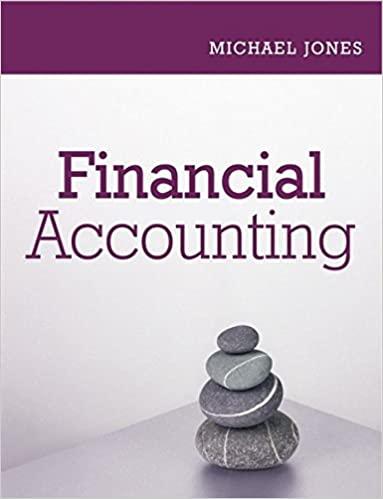Question
1. As of December 31 st , wages of $45,700 should be accrued; associated payroll taxes on these wages are $2,910. (Record in two separate
1. As of December 31st, wages of $45,700 should be accrued; associated payroll taxes on these wages are $2,910. (Record in two separate adjusting entries. The payroll taxes are an expense to the company for unemployment benefits and recorded as a payable to the state & federal taxing authority.)
2. The Unearned Consulting Revenue account has a balance before adjustment of $261,220 as of December 31, 20x1. Of this balance, 70% of the work was completed by year end.
3. You discover that a sale of a product was made on account and CMC recorded the sale in December for $136,200. However, the product has not yet been shipped, therefore it is not considered to be delivered to the customer. The cost of the product was 55% of its selling price. CMC uses the perpetual inventory method.
4. At year-end, the CFO asks you to review the Accounts Receivables to determine if there are any customer accounts that should be written off as uncollectible. Based on your review, you determine that the Account Receivable from Shift, Co. has been past due for over 14 months and Shift recently declared bankruptcy. The CFO instructs you to write off the account balance of $21,350. Directly following this action, you can now record bad debt expense which is estimated to be 5% of ending Accounts Receivable. (Round to the nearest whole dollar.)
5. CMC prepays for its property & casualty insurance. As of December 31, 20x1, 80% of the prepayments have now been consumed. (Round to the nearest whole dollar.)
6. CMC records depreciation and amortization expense annually. They do not use an accumulated amortization account. (i.e. Amortization Expense is recorded with a debit to Amort. Exp and a credit to the Patent.) Annual depreciation rates are 5% for Buildings/Equipment/Furniture, no salvage. (Round to the nearest whole dollar.) Annual Amortization rates are 10% of original cost, straight-line method, no salvage. CMC owns two patents: Patent #FJ101 has an original cost of $154,000 and Patent #CQ510 was acquired for $169,000. The last time depreciation & amortization were recorded was December 31, 20x0.
7. The long-term liabilities were outstanding for all of 20x1 and accrue interest at 8% APR. CMCrecords accrued interest quarterly (interest was last updated on Sept. 30.) The company is required to pay the interest annually each January 1st.
8. CMC often allows customers to finance the purchase of their products through long-term lending agreements and therefore reports Long-term Notes Receivable on their Balance Sheet. These notes are interest bearing and earn CMC interest revenue. The notes accrue interest at 8% APR and were outstanding for all of 20x1. Interest is payable to CMC each January 1st.
9. On December 15, CMCdeclareda dividend of $220,000, to be paid on January 20, 20x2. The dividend declaration had not yet been recorded.
10. At December 31, the Long-Term Investments (Available-for-sale securities or AFS) had a fair value of $195,400. The AFS Investment was originally purchased on June 1, 20x1 for $160,500. CMCuses a Fair Value Adjustment account (an adjunct/contra account to the Investments) to mark-to-market the investment portfolio at year end. (e.g. If the fair value of the Investment has increased at year end, debit the Fair Value Adjustment account in order to increase the Carrying Value of the asset to equal its fair value on the balance sheet at Dec. 31st. This is an unrealized (holding) gain, which would require a credit to record it.)
11. CMCs Income tax rate for 20x1 was determined to be 21%.
What are the Adjusting Journal Entries for 1-11?
Thank you !



- You will have (5) closing entries. They include the following:
- Closing Entry #1: Close ALL revenues to Income Summary. The credit to Income Summary will therefore represent Sales Rev + Service Rev + Interest Rev for the period.
- Closing Entry #2: Close ALL expenses to Income Summary. Every individual expense, loss, sales returns & discounts account must be closed out with a credit, and the sum of all expenses/losses/returns & discounts can then be debited to your Income Summary in this entry.
- Closing Entry #3: Take the difference between the credit posted to Income Summary (Closing Entry #1) less the debit posted to Income Summary (Closing Entry #2) to close out the Income Summary account and permanently move NI to R.E.
- Closing Entry #4: Close out the dividend directly to R.E.
- Closing Entry #5: Close the Unrealized Gain-AFS (the account title that appears on your Comprehensive Income Statement) to Accumulated Other Comprehensive Income (the equity account on the balance sheet). This closes out your Other Comprehensive Income (OCI) account & transfers its balance to your permanent Balance Sheet account Accumulated Other Comprehensive Income. Just like NI is permanently closed into Retained Earnings, your OCI items from the current year also need to be closed out and permanently stored in the Accumulated OCI account under Stockholders Equity on your Balance Sheet.
Step by Step Solution
There are 3 Steps involved in it
Step: 1

Get Instant Access to Expert-Tailored Solutions
See step-by-step solutions with expert insights and AI powered tools for academic success
Step: 2

Step: 3

Ace Your Homework with AI
Get the answers you need in no time with our AI-driven, step-by-step assistance
Get Started


